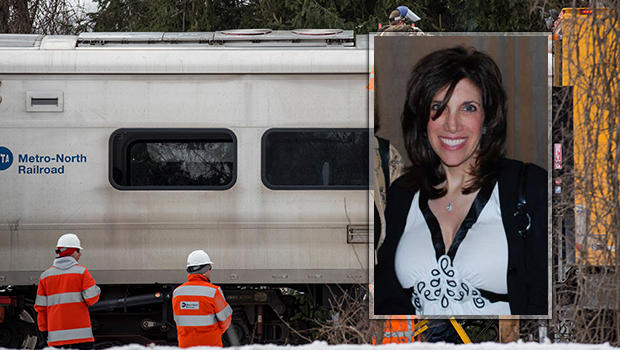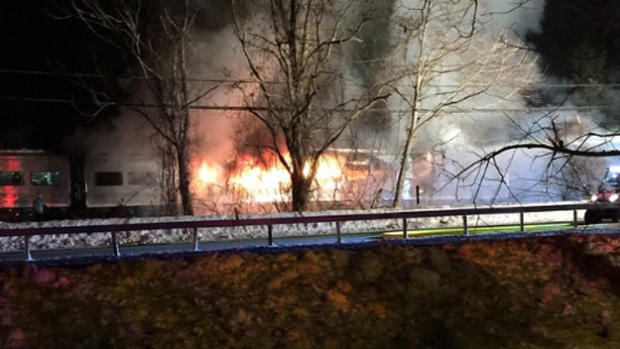Officials focus on SUV driver in deadly NY train crash
VALHALLA, N.Y. - The baffling behavior of a woman whose Mercedes SUV stopped between the crossing gates on a railroad track came under scrutiny Wednesday as investigators sought clues to a fiery commuter train crash that killed six people in Valhalla, about 20 miles north of New York City.
National Transportation Safety Board officials were looking at the Metro-North train's black-box-style recorders, seeking to learn its speed, whether brakes were applied and whether it sounded its horn as it approached the suburban New York crossing where it slammed into the SUV during Tuesday's rush hour, NTSB vice chairman Robert Sumwalt said.
At a Wednesday afternoon press conference, Sumwalt said it was unclear why the SUV being driven by Ellen Brody, 49, had stopped in the crossing just before it was hit by the train, killing her and five others who were passengers on the train.
Investigators also planned to look at the track signals' recording devices, interview the train's operators, peer into the wreckage with laser-scanning devices and seek aerial footage, he said. Sumwalt said he has no indication currently that the crossing's safety gates were not working properly.
"The big question everybody wants to know is why was this vehicle in the crossing," Sumwalt said. "Throughout the next several days our investigators will continue to document the scene."
"We intend to find out not only what happened, but we want to find out why it happened," he said earlier Tuesday at the site of the collision.
Meanwhile, officials were using dental records to identify the badly burned victims - five men on the train and the SUV driver, officials said. Several others remained hospitalized, at least two with critical or serious injuries.
Tuesday's crash was the deadliest accident in the 22-year history of one of the nation's busiest commuter railroads - one that has come under a harsh spotlight over a series of accidents in recent years.
"It's really inexplicable, based on the facts we have now," Gov. Andrew Cuomo said on WCBS-AM radio.
The wreck happened in an area where the tracks are straight but car traffic can be tricky, as drivers exiting or entering a parkway turn and cross the tracks near a wooded area and a cemetery.
The driver had gotten out of her Mercedes SUV momentarily after the crossing's safety gates came down around her and hit her car, according to the driver behind her, Rick Hope.
"I said to myself, 'The clock is ticking here, the gate is down, the bells are ringing - what are you going to do here?'" he told WNYW-TV. "She looked a little confused, gets back in the car and pulls forward" on the tracks.
Traffic was moving slowly, choked with drivers seeking to avoid the Taconic Parkway because of an accident, he noted.
"It looks like she stopped where she stopped because she didn't want to go on the tracks," Hope added. "It was dark, so maybe she didn't know she was in front of the gate."
Railroad grade crossings typically have gate arms designed to lift automatically if they hit a car or other object on the way down, railroad safety consultant Grady Cothen said. The wooden arms are designed to be easily broken if a car trapped between them moves forward or backward, he said.
As of Wednesday morning, transit officials hadn't found any problems with the tracks or signal, Westchester County Executive Rob Astorino said.
It was not the first deadly crash at the site: A Metro-North train hit a truck, killing its driver, at the same Commerce Street crossing in 1984, according to Federal Railroad Administration records.
The impact of Tuesday's crash was so powerful that the electrified third rail came up and pierced the train, and the SUV was pushed about 400 feet.
Cuomo said the SUV's gas tank apparently exploded, starting a fire that consumed the SUV and the train's first car, which was left blackened and mangled.
Elizabeth Bordiga was commuting home from her New York City nursing job when she suddenly felt the train jerk a few times. She and other passengers in the middle part of the train started calmly walking to the back. But then they started smelling gasoline, "and somebody said, "There's a fire," she recalled.
But they couldn't open the emergency window or figure out how to escape until a firefighter in the train got a door open, she said. Commuters lifted each other down from the train to the ground about 7 feet below, said Bordiga, who uses a cane.
"When I was on the ground, I looked to the right and saw flames. I couldn't believe it," she said.
In the first car, a man whose own hands were burned elbowed open the emergency exit latch, allowing some of the train's roughly 700 passengers to escape, passenger Christopher Gross recalled on ABC's "Good Morning America."
The train's engineer tried to rescue people until the smoke and flames got so severe that he had to escape, Astorino said.
Every day, trains travel across more than 212,000 highway-grade rail crossings in the U.S. There are an average of 230 to 250 deaths a year at such crossings, down over 50 percent from two decades ago, FRA figures show.
Risky driver behavior or poor judgment accounts for 94 percent of grade crossing accidents, according to a 2004 government report.
Metro-North is the nation's second-busiest commuter railroad, after the Long Island Rail Road, serving about 280,000 riders a day.
Late last year, the NTSB issued rulings on five Metro-North accidents in New York and Connecticut in 2013 and 2014, repeatedly finding fault with the railroad.
Among the accidents was a 2013 derailment that killed four people, the railroad's first passenger fatalities, in the Bronx. The NTSB said the engineer had fallen asleep at the controls because of a severe, undiagnosed case of sleep apnea.

